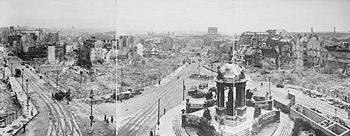103rd Heavy Anti-Aircraft Regiment, Royal Artillery
The 103rd Heavy Anti-Aircraft Regiment (103rd HAA Rgt) was an air defence unit of the British Army's Royal Artillery during World War II.
It saw action during the Liverpool Blitz, landed on D-Day and served throughout the subsequent campaign in North West Europe and defended the cities of Belgium against V-1 flying bombs.
[3][9][10][11] After attending practice camps, the batteries moved to Liverpool to take over gun sites from other regiments, including 93rd (3rd West Lancashire) HAA Rgt, which also transferred some of its men to the 103rd.
[4] The night raids continued into the following Spring, during which period the city and its docks along the Mersey became the most heavily bombed area of Britain outside London.
It began mobile training in August and then took part in large scale exercises before returning to the Mersey sites in the autumn, where it was regularly in action again.
[4] In the autumn of 1940 the regiment had sent a cadre to 210th AATR at Oswestry to provide the basis for a new 390 Bty; this was formed on 14 November 1940 and later joined 107th HAA Rgt.
[1][16][19] In West Cornwall the main threat was from low level 'hit and run' raids by single-engined Luftwaffe aircraft (such as attacks by pairs of Focke-Wulf Fw 190s on St Ives on 28 August and Truro on 7 September), which were difficult for HAA guns to engage.
[19][20] Apart from a short training deployment in Hampshire in the summer (when the regiment formed a temporary No 7 Troop to continue manning a site at Land's End), 103rd HAA Rgt remained in Cornwall until October 1942.
Howard Erskine Johnston had experienced rapid promotion since he had been commissioned as a TA 2nd Lieutenant in the 93rd HAA Rgt early in 1939, becoming an acting Lt-Col in November 1942.
Among this group, B Troop of 322/103 HAA Bty would have a secondary coastal artillery role to protect shipping off Queen sector from attack by German E-boats, particularly at night.
Given the low intensity of air attacks, HAA guns in the bridgehead were sometimes made available to fire on ground targets for bombardment, counter-battery and anti-tank shoots.
[29][34][37][38] July continued the same pattern: a number of AA rounds expended most nights, more fired in support of ground operations around Caen, and a trickle of casualties from occasional shellfire and bombs.
From 7 to 9 July, 324 Bty fired at enemy observation posts (OPs) and other targets in the Colombelles factory area while I Corps attacked Caen (Operation Charnwood).
[39][40][41] 21st Army Group broke out from the Normandy beachhead at the end of August and began to pursue the defeated German troops across Northern France.
The regiment rejoined 80th AA Bde at the liberated port of Dieppe, where the responsibilities included security of a large Prisoner-of-war camp, and helping to unload ships at the docks.
[29][34][43] Large targets in the liberated areas such as Brussels and the port of Antwerp were vulnerable to attack by V-1 flying bombs (codenamed 'Divers'), and GHQ planned large-scale AA defence schemes for the cities, 'Antwerp X' and 'Brussels X', integrating guns and early warning radar.
[29][34][44] By mid-December, the Royal Navy had become concerned about the safety of the channel leading from Zeebrugge up the Scheldt Estuary to the vital supply base of Antwerp, and more HAA guns were sent to cover it.
[39][45] On 1 January 1945, the Luftwaffe launched Operation Bodenplatte: daylight attacks by single-engined fighters against Allied airfields in support of the Ardennes offensive; the Scheldt Approaches guns claimed to have shot down six of these.
[45][47] That month the regiment began to receive the machine fuze setter MFS No 11A, which increased the rate of fire of the 3.7-inch gun to 20 rounds per minute.
In March, it lent a platoon of its AEC Matador HAA gun tractors to 21st Army Group to assist in transporting engineering stores for the assault crossing of the Rhine (Operation Plunder).
[51] The regiment was ordered to concentrate at Hoogerheide on 23 April and come under the command of 76th AA Bde, which was handling unit disbandments and conversions to other roles.



